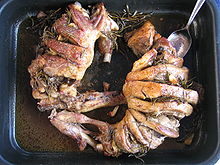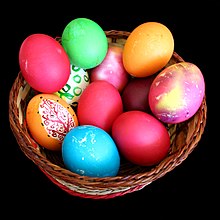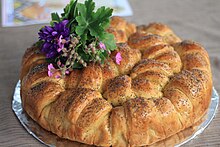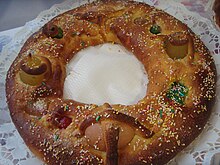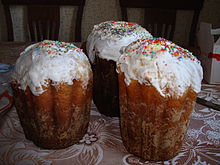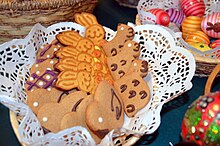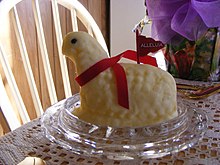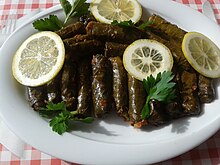Easter food
[6][7][8] In addition, one ancient tradition was the staining of Easter eggs with the colour red "in memory of the blood of Christ, shed as at that time of his crucifixion.
A hot cross bun is a spiced bun usually made with fruit, marked with a cross on the top, which has been traditionally eaten on Good Friday in the United Kingdom, Australia, New Zealand, South Africa, Canada, India, Pakistan, Malta, United States and the Commonwealth Caribbean.
[30] The crust is a chocolate cookie crumb crust, variations of which can be made with crumbled sandwich cookies, or by melting chocolate in a double boiler and stirring in crisped rice cereal, then pressing the mixture into a pie dish and allowing it to set in the refrigerator.
[32] For lunch or dinner on Holy Saturday, families in Sweden and Denmark traditionally feast on a smörgåsbord of herring, salmon, potatoes, eggs, and other kinds of food.
In Greece, the traditional Easter meal is mageiritsa, a hearty stew of chopped lamb liver and wild greens seasoned with egg-and-lemon sauce.
[33] Regional names for flaouna include vlaouna, fesoudki (Greek: φεσούδκι) in Karavas, and aflaouna in Karpasia.
[33] Flaounes are traditionally served in Cyprus, parts of Greece (especially Arcadia) and more widely in the Greek diaspora as a celebratory food for the breaking of the Lenten fast, being prepared on Great and Holy Friday for consumption on Easter Sunday.
[36] Koulourakia or Koulouria, are a traditional Greek dessert, typically made around Easter[37] to be eaten after Holy Saturday.
[41][42][43] It is made by combining milk, eggs and sugar and boiling the mixture, stirring often, until it begins to lump, much like curd cheese or quark.
The dough is then fashioned into a dove shape (colomba in Italian) and finally is topped with pearl sugar and almonds before being baked.
[51] Pastiera is a type of Neapolitan tart made with cooked wheat, eggs, ricotta cheese, and flavoured with orange flower water.
[54] In Jamaica, eating bun and cheese is a highly anticipated custom by Jamaican nationals all over the world.
According to the Jamaica Gleaner, "The basic Easter bun recipe requires wheat flour, brown sugar, molasses, baking powder or yeast and dried fruits.
They are mostly used in Mexico during Carnival, but in American and Mexican border towns, the cultures combined to make them a popular Easter tradition.
When a child would act up, their father would crack an egg over their head as a consequence, and a way of showing their disappointment in them.
In addition to Easter, cascarones have become popular for occasions including birthdays, New Year's, Halloween, Cinco de Mayo, Dieciséis, Day of the Dead, and weddings.
The butter lamb (Baranek wielkanocny) is a traditional addition to the Easter meal for many Polish Catholics.
Pão de Ló is a Portuguese sponge cake made of eggs, sugar, and wheat flour.
Unlike the pão de ló seen today, it was a thick pudding made solely with ground almonds instead of wheat flour.
[73][74] Historically, these sweet breads were generally reserved for festive occasions such as Easter or Pentecost and were typically given as gifts.
[76] Outside of Portugal, Portuguese "sweet bread" transliterated as "pão doce" is often associated with Azorean "massa sovada" which are similar but traditionally prepared differently.
[77][78] Many traditional Portuguese sweet breads are defined by the associated region or by the convents, artisan bakers or religious confraternities (similar to a guild) that historically made them.
Since many have deep historical and cultural significance to the area which they originate from, these breads are as well as other foods and ingredients are inventoried by the Portuguese governmental office Directorate-General for Agriculture and Rural Development (DGARD), which collaborates with a collective of independent confraternities known as the Portuguese Federation of Gastronomic Confraternities (FPCG) throughout Portugal.
[83] Marañuela is a typical sweet from Asturias, Spain, made mainly by flour, sugar, eggs, clarified butter and lemon zest.
[88] Preparations for Easter celebration in Ukraine begin weeks before the feast day, with Great Lent being part of it.
Paskha (also spelled pascha, or pasha) is a Slavic festive dish made in Eastern Orthodox countries which consists of food that is forbidden during the fast of Great Lent.
It is usually served as an accompaniment to rich Easter breads called paska in Ukraine and kulich in Russia (where the "paskha" name is also used in the Southern regions) and Poland “Pascha”.
[92] The Easter foods; bread and cheese paska are very rich and made of many dairy items given up during Great Lent.
It is eaten in countries like Russia, Belarus, Ukraine, Romania, Armenia, Georgia, Moldova, North Macedonia and Serbia.
Easter breads are a traditional element in the Easter holidays of Armenia, Austria, Belarus, Bosnia and Herzegovina, Bulgaria, Croatia, the Czech Republic, Georgia, Germany, Greece, Hungary, Italy, Lithuania, Moldova, Montenegro, North Macedonia, Poland, Romania, Russia, Serbia, Slovakia, Slovenia, Switzerland and Ukraine.
